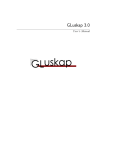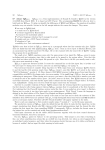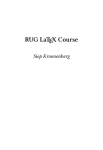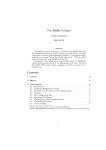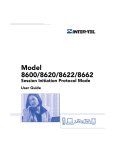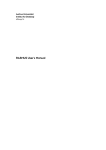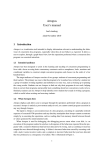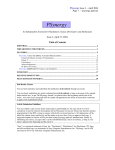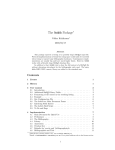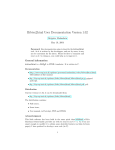Download BibTEX yesterday, today, and tomorrow
Transcript
BibTEX yesterday, today, and tomorrow
Oren Patashnik
San Diego, CA
Abstract
This paper looks back at the last 20 years of BibTEX, and also looks ahead, if not
to the next 20 years, then at least to BibTEX 1.0.
Introduction
BibTEX is the bibliography program designed originally to accompany Leslie Lamport’s LATEX; it now
works with other incarnations of TEX, too. BibTEX
removes the tedium, and adds some flexibility, in
producing a reference list.1 When BibTEX creates
your reference list, it’s BibTEX, not you, minding
the minutiae like ensuring that your reference-list
entries are in the correct order, that every comma
is in place, and that the information is formatted
consistently across entries. Furthermore, a single,
simple, change of bibliography-style name lets you
convert your reference list from style A, which might
order the entries alphabetically, and spell out journal names in full, and list all authors as first-name
then last-name, to a completely different style B,
which might order the entries according to their order of mention in the text, and abbreviate journal
names, and invert just the first author’s first and
last names.
This paper is an updated version of a paper [7]
from the 1994 TUG meeting in Santa Barbara. It
gives: a history of BibTEX to the present; the general goals for BibTEX 1.0, which will be the frozen
version of BibTEX (just as TEX 3 is the frozen version of TEX); some specific new features for achieving those goals; and the plan for releases of BibTEX
leading up to BibTEX 1.0. Before all that, however,
primarily for those who are unfamiliar with BibTEX,
comes a section that explains its rudiments.
Using BIBTEX
To use BibTEX, you’ll have your bibliographic information in a bibliography database, and, to make
use of that information, a few (LA)TEX2 commands
sprinkled throughout your (LA)TEX source file.
1 Throughout this paper, the term ‘reference list’ is used
generally to refer to what might also be called a ‘bibliography’
or a ‘list of sources’ or anything similar.
2 The term ‘(L
A)TEX’ is used to mean either L
ATEX or plain
(or other variations of) TEX.
For example in a file mybib.bib (database file
names end with .bib) you might have an entry like:
@BOOK{knuth:tex,
author = "Donald E. Knuth",
title = "The {\TeX}book",
publisher = "Addison-Wesley",
year = "1984",
}
The @BOOK tells BibTEX the entry type. (The bibliography style will instruct BibTEX on how to format
a BOOK entry type.) The knuth:tex is the database
key, which is a sequence of characters to be used as
the symbolic name for this entry. And the rest of
the entry comprises four hfieldi = hfield-valuei pairs
appropriate for a BOOK entry type. In general you
will have many such entries in a database file; you
might also have multiple database files.
And in your (LA)TEX source file you might have
a citation like
... in the \TeX{}book~\cite{knuth:tex} ...
The \cite command’s argument knuth:tex, called
a cite key, must match the corresponding database
key. (LA)TEX might typeset this \cite command as
. . . in the TEXbook [41] . . .
or
. . . in the TEXbook41 . . .
or
. . . in the TEXbook (Knuth, 1984) . . .
depending on the citation style. LATEX’s default citation style uses a number in brackets, and for that
citation style, together with an appropriate bibliography style, the corresponding reference-list entry
might look like:
41. Donald E. Knuth. The TEXbook. AddisonWesley, 1984.
Besides the \cite commands, your (LA)TEX source
file will also have two BibTEX-related commands:
\bibliography{mybib}
\bibliographystyle{plain}
TUGboat, Volume 24 (2003), No. 1 — Proceedings of the 2003 Annual Meeting
25
Oren Patashnik
The \bibliography command does two things: It
tells (LA)TEX to put the reference list at that spot in
your document, and it tells BibTEX which file(s) to
use for the bibliographic database, here just the single file mybib.bib. The \bibliographystyle command tells (LA)TEX nothing, but tells BibTEX which
bibliography style to use, here the standard style
plain; bibliography style file names end with .bst,
thus the relevant file is plain.bst in this case.
So with your database file(s) and your (LA)TEX
source file structured appropriately, your citations
are formatted according to the citation style, and
your reference list is formatted according to the bibliography style.
To actually produce the typeset document, you
run (LA)TEX, BibTEX, (LA)TEX, (LA)TEX. The first
(LA)TEX run writes, to an .aux file, information for
use by BibTEX — which bibliography style to use,
which database file(s) to use, and which database
entries to include. The BibTEX run reads all that
information from the .aux file, reads the specified
database (.bib) file(s), formats the reference list according to the instructions in the bibliography style
(.bst) file, and writes its output onto a .bbl file.
The next (LA)TEX run reads the .bbl file and incorporates the reference list into the document. The
final (LA)TEX run fixes the references into the reference list. Figure 1 shows the files that BibTEX uses.
The .blg file is BibTEX’s log file, in which BibTEX
records any warning or error messages.
To try using BibTEX with LATEX, put the sixline BOOK entry shown on the previous page into a
file called mybib.bib, and then, into a file called
mypaper1.tex, put these six lines of LATEX:
\documentclass{article}
\begin{document}
The \TeX{}book~\cite{knuth:tex} is good.
\bibliography{mybib}
\bibliographystyle{plain}
\end{document}
Exactly how you run LATEX and BibTEX is system
dependent; on my system I issue four commands:
latex mypaper1
bibtex mypaper1
latex mypaper1
latex mypaper1
To try using BibTEX with plain TEX, create the file
mybib.bib as above, and then put into a file called
mypaper2.tex these seven lines of plain TEX:
\input btxmac
The \TeX{}book~\cite{knuth:tex} is good.
\medskip
\leftline{\bf References}
\bibliography{mybib}
26
.aux
.bst
.bib
@
@
R ?
@
BibTEX
A
AAU
.bbl
.blg
Figure 1: BibTEX’s input and output files.
\bibliographystyle{plain}
\bye
To run mypaper2 through TEX and BibTEX:
tex mypaper2
bibtex mypaper2
tex mypaper2
tex mypaper2
The file btxmac.tex, which mypaper2.tex \inputs,
contains the macros that make BibTEX work with
plain TEX. Those macros are a standard part of
most TEX distributions, but if they’re not a part of
yours, you’ll have to go fetch a copy.
That’s a brief introduction to BibTEX. The following sources provide further details. Leslie Lamport’s LATEX manual [4] explains how to use BibTEX
with LATEX. In particular, section B.1 describes the
.bib-file format in detail. The file btxmac.tex [1]
documents its own use, with or without Karl Berry’s
eplain.tex package (for which the btxmac macros
were originally written). The “BibTEXing” document [5], which is distributed along with BibTEX
itself, contains further hints for BibTEX users. The
“Designing BibTEX Styles” document [6], also distributed with BibTEX, explains the postfix stackbased language used to write BibTEX bibliography
styles (.bst) files. The LATEX Companion (2nd edition) [2], by Michel Goossens, Frank Mittelbach,
et al., and Guide to LATEX [3], by Helmut Kopka and
Patrick W. Daly, summarize much of the information in the sources above, and describe some of the
tools available for helping with BibTEX. BibTEX’s
standard bibliography styles, like plain, are based
on Mary-Claire van Leunen’s A Handbook for Scholars [9]. That book is worthwhile reading for anyone
wanting to design a bibliography style from scratch.
History
Leslie Lamport patterned LATEX after a document
production system called Scribe [8], written by Brian
Reid in the late 1970s at Carnegie-Mellon University. One of Scribe’s basic tenets was that, to the
extent possible with a computer program, writers
should be allowed to concentrate on content rather
TUGboat, Volume 24 (2003), No. 1 — Proceedings of the 2003 Annual Meeting
BibTEX yesterday, today, and tomorrow
than on formatting details. Or, as Reid so amusingly
put it:3
Not everyone should be a typesetter.
I think of LATEX as a fairly successful Scribification
of TEX — LATEX is almost as easy to use as Scribe
yet almost as powerful as TEX.
In any case, Scribe had become popular in certain academic circles, and Lamport decided that, to
make it easy for Scribe users to convert to LATEX, he
would adopt Scribe’s bibliography scheme in LATEX.
But TEX macros alone were insufficient in practice
to do all the things, like alphabetizing, that a bibliography processor needs to do; he decided instead
to have a separate bibliography program. That program would manipulate the bibliographic information in Scribe-like database files according to the
instructions programmed in a special-purpose style
language. The postfix stack-based language he had
in mind was to be powerful enough to program many
different bibliography styles.
My own work on BibTEX started in February
1983. Just for the fun of it, I went back and dug up
the original email:
15-Feb-83 0908
To: OP@SU-AI, tex82@SRI-CSL
Oren,
Leslie Lamport is working on a new
macro package for TeX82, and needs
someone to write a support program
or two. We are volunteering you. His
address is TEX82@SRI-CSL. Why don’t
you get in contact with him, and see
whether his requirements are within
the scope of what you’re willing to do.
This was described as a “three-week project”, and
the first time I gave this talk, at Santa Barbara
in 1994, I compared the “three-week project” to
the “three-hour tour” of the 1960’s American television series Gilligan’s Island, in which an afternoon’s
harbor cruise became a shipwreck adventure lasting
years. (Many of us at that TUG conference really
did go on a three-hour harbor cruise.)
This year’s meeting was on the Big Island of
Hawaii, though, and it struck me that there’s an
even better metaphor for my work on BibTEX than
the Gilligan’s Island adventure: I started working
on BibTEX, it turns out, within days of when the
current eruptive phase of Kilauea began, in early
1983. And a volcano aptly describes my work on
BibTEX — a burst of activity, followed by a dormant
stretch. (2004 will be more active than dormant.)
3 — to a Bell Labs Computer Science Colloquium audience that included some troff true believers
But back to 1983. Over the course of the next
year and a half I implemented Lamport’s basic design, with a few enhancements. The first working
version of BibTEX (0.41) trudged forth in the summer of 1984. Lamport wrote, and Howard Trickey
modified, a bibliography style based on Mary-Claire
van Leunen’s suggestions in her Handbook for Scholars [9]. Trickey’s modified version was to become
btxbst.doc, the template for BibTEX’s four standard styles plain, abbrv, alpha, and unsrt. (By
the way, these are called “standard” styles not because they are supposed to be some sort of standard, but because they are in the standard release
of BibTEX.)
The first public release of BibTEX, in March
1985, was version 0.98, for LATEX version 2.08. Several upgrades, including one for LATEX 2.09, followed
later that year. Version 0.99, which added many
new features, was released in January 1988; two minor upgrades followed the next month, but BibTEX
itself has remained unchanged since then. The standard styles have been unchanged since March 1988.
In 1990 Karl Berry wrote some macros, for use
in his eplain.tex package, that made BibTEX usable with plain (and other versions of) TEX. He
and I modified the macros and released them as
btxmac.tex in August 1990, usable with or without the eplain package. Several upgrades followed,
the last in March 1995.
The current versions are: 0.99c for BibTEX itself; 0.99b for btxbst.doc (the standard styles’ template file — but version 0.99a for each of the four
standard styles); and 0.99k for btxmac.tex.
That’s for the software I’ve worked on. There
has, in addition, been work that others have done
to support BibTEX, especially in the last decade:
• software for the handling of database (.bib)
files (my personal database-handling preference
is the text editor Emacs’s BibTEX mode, but I
don’t recommend that others join the Emacs
religion just for that);
• the amassing of many database files for public
consumption, minimizing the amount of work it
takes to create new entries (Nelson Beebe has
been particularly prolific in that regard);
• software for generating new bibliography styles
automatically, without having to know details
of the somewhat arcane .bst bibliography-style
language (Patrick Daly’s custom-bib/makebst
package has gotten widespread use — more on
this later).
That brings us up to date.
TUGboat, Volume 24 (2003), No. 1 — Proceedings of the 2003 Annual Meeting
27
Oren Patashnik
bibliography-style customization
Goals
BibTEX has been very stable for some time now.
Software stability is nice; it helps others build tools
that augment the software. As suggested above,
many tools have grown up around BibTEX. The
popularity of (LA)TEX, however, has taken BibTEX
into places not anticipated, necessitating changes.
Here are some general goals for BibTEX 1.0:
• Easier nonstandard styles: The most frequent
requests I see are for new bibliography styles.
Creating a new bibliography style generally entails programming in the .bst language, which,
for most users, is not an easy task. Patrick
Daly’s custom-bib/makebst package has made
it reasonably easy for ordinary user to create
new bibliography styles; for BibTEX 1.0 the situation will improve even more.
• More international: BibTEX has spread to the
non-English-speaking world. BibTEX 1.0 will
address associated issues.
• More fields of study: The original BibTEX users
were from the technical world of mathematics
and computer science. The BibTEX 1.0 standard styles will do more to accommodate those
in other fields, like the humanities.
• Enhanced sharing capabilities: There now exist huge .bib-file bibliographic databases, some
available to users world wide. BibTEX 1.0 will
make the sharing of those databases easier.
• Better documentation: The BibTEX 1.0 documentation will be more extensive.
• FroZEN: For even better stability, BibTEX 1.0
will be frozen. As with TEX 3.0, it will be upgraded for bug fixes only.
Some of the features planned for implementing those
goals appear in the next section.
New features
Over the years I have accumulated a list of new features and probable changes for BibTEX 1.0 and its
standard styles. The list below is certainly not exhaustive, but it contains the most important items.
Each one listed has a high probability of existing in
BibTEX 1.0.
• Software for generating customized bibliography style (.bst) files: In Santa Barbara I had
claimed that there would be a Bibsty program
to do that, similar in spirit to the processing
that creates the four standard styles from the
current template file btxbst.doc, but with lots
more options. That Bibsty program, however,
would partly duplicate what Patrick Daly has
28
?
.aux
.bst
.bib
@
@
R ?
@
BibTEX
A
AAU
.bbl
.blg
Figure 2: BibTEX 1.0 input and output files.
done with the custom-bib/makebst package.
So he and I have decided to collaborate for
BibTEX 1.0 on a system that will include the
options of his current code, along with some
things planned for the Bibsty program. This
system will have, among other options, an easily changed symbolic name for each string that
a bibliography style outputs to the .bbl file
directly (such as ‘editor’ or ‘volume’), making
it easier to, for example, convert bibliography
styles from one language to another. Figure 2
shows how the new style customization system
will fit into the scheme.
• Eight-bit input: Most current BibTEX implementations can handle 8-bit input; BibTEX 1.0
will guarantee, at a minimum, to support the
character-set conventions of TEX 3. In addition, BibTEX 1.0 may be able to accommodate
Unicode.
• Multiple bibliographies within a single document: Many large documents contain several
bibliographies — one bibliography per chapter
for a book, or one per paper for a conference
proceedings. Several solutions have arisen for
handling such situations, but BibTEX 1.0 will
support multiple bibliographies directly.
• Enhanced sorting: The current BibTEX does
well with English, but doesn’t gracefully handle certain unusual sorting conventions of other
languages, like Hungarian; BibTEX 1.0 will have
more powerful sorting capabilities for handling
them.
• Reference-list back pointers: BibTEX 1.0 will
provide a direct mechanism for indicating in a
reference-list entry where in the text that entry
was cited. This is a useful feature that I suspect will become widespread now that our new
typesetting technology makes it painless.
TUGboat, Volume 24 (2003), No. 1 — Proceedings of the 2003 Annual Meeting
BibTEX yesterday, today, and tomorrow
• An @ALIAS command: Suppose you have an entry in a database file that uses a different database key, say knuth:tex, from the cite key you
prefer, say texbook; this might happen, for example, if that entry is in a shared database file.
With BibTEX 1.0 you will be able to keep the
cite key and database key as is, as long as you
put a command like
@ALIAS{texbook = knuth:tex}
somewhere in your database.
• A @MODIFY command: With BibTEX 1.0 you
will be able to create a slightly altered version of
an entry. For example, you might want to add
a note field to an entry in a public database file
without having to repeat in your own personal
database file all the information in that entry:
@MODIFY{laws-of-the-game,
note = "Law~8 discusses restarts",
}
The @MODIFY command’s database key should
match the one from the public database.
• Distinguishing among identical database keys:
If you are using two different database files that
happen to use the same database key for different entries, you will be able to specify which
entry you want by using a citation of the form
\cite{filename::database-key}
• A .bib-file extraction mode: BibTEX 1.0 will
have a mode that will let you extract just the
information you need into a small .bib file. For
example if you are submitting a paper to a journal that wants a .bib file in addition to a .tex
file, but the bibliographic database you are using for the paper is huge, you can use the extraction mode to put just the entries you need
for the paper into a separate .bib file that you
can then send to the journal.
• A \bibtexoptions (LA)TEX command: Communication from (LA)TEX to BibTEX 1.0 will
improve with this command.
• Extensions to the \cite command: Many citation styles aren’t handled very gracefully by
(LA)TEX’s current \cite command. BibTEX 1.0
and (LA)TEX will more directly support more
flexible \cite commands.
• Also appeared as: Sometimes a work appears
in two different forms, for example as a journal
article and then later in the author’s collected
works. BibTEX 1.0 will have a mechanism to
handle this.
• Name handling: BibTEX 1.0 will have enhanced
(but upward compatible) name processing, for
example for complicated Spanish surnames, and
for inverted-order Asian names.
• Standard-style changes: There will be lots of
additions to the BibTEX 1.0 standard styles,
allowing many more options.
• New fields: The standard styles will also include
a bunch of fields that are not now a part of
the standard styles, including day, isbn, issn,
keywords, eprint, translator, and url.
• New entry types: There will also be a few new
entry types, including @PERIODICAL and perhaps @PATENT.
• .bst-language changes: There will be a few minor (but compatible) changes to the .bst language.
• btxmac.tex update: These macros will be updated so that the user interfaces to BibTEX 1.0
from LATEX and plain TEX are as similar as possible.
• Documentation: The “BibTEXing” and “Designing BibTEX Styles” documents [5, 6] currently distributed with BibTEX are neither as
widely known nor as complete as they could be.
For BibTEX 1.0, the main documentation will
be in a book, and will be much more thorough.
Among other things, it will include a .bib-file
grammar, so that those who are writing tools
to manipulate the database files can make their
software more robust.
Planned releases
2004 will see the release of an updated version of
the btxmac.tex macros. Probably toward the end
of the year will come a bug-fix version of BibTEX
0.99. (There are just a handful of actual bugs to
BibTEX itself, the most annoying being its mishandling of URLs, which didn’t even exist when the current BibTEX was released.)
There will be several beta releases of BibTEX
and its standard styles, leading up to 1.0; eventually
one of those beta releases will be declared to be 1.0
and frozen.
Until BibTEX 1.0 is finished, I will skim the
comp.text.tex newsgroup for BibTEX-related postings, so it suffices to post there anything you think
I should see. In general that’s a good place to post
questions about BibTEX — usually someone posts
a useful reply. (Occasionally I’ll reply by private
email.)
TUGboat, Volume 24 (2003), No. 1 — Proceedings of the 2003 Annual Meeting
29
Oren Patashnik
References
[1] Karl Berry and Oren Patashnik. btxmac.tex.
Macros to make BibTEX work with plain TEX;
current version 0.99k, 13 November 1995.
[2] Michel Goossens and Frank Mittelbach, with Johannes Braams, David Carlisle, and Chris Rowley. The LATEX Companion. Addison-Wesley, 2nd
edition, 2004.
[3] Helmut Kopka and Patrick W. Daly. Guide to
LATEX. Addison-Wesley, fourth edition, 2003.
[4] Leslie Lamport. LATEX: A Document Preparation System. Addison-Wesley, second edition,
1994.
[5] Oren Patashnik. BibTEXing. General documentation for BibTEX users, contained in the file
btxdoc.tex, 8 February 1988.
30
[6] Oren Patashnik. Designing BibTEX styles. Documentation for BibTEX style designers, contained in the file btxhak.tex, 8 February 1988.
[7] Oren Patashnik. BibTEX 1.0. TUGboat, 15:269–
273, 1994.
[8] Unilogic, Ltd., Pittsburgh. Scribe Document
Production System User Manual, fourth edition,
April 1984. Chapter 12 and appendices E8
through E10 deal with bibliographies.
[9] Mary-Claire van Leunen. A Handbook for Scholars. Oxford University Press, revised edition,
1992.
TUGboat, Volume 24 (2003), No. 1 — Proceedings of the 2003 Annual Meeting







